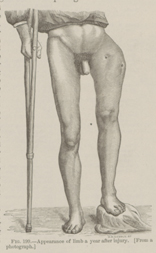Title: Riley, Peter
Source text: The Medical and Surgical History of the War of the Rebellion. (1861-65.), Part 3, Volume 2 (Washington, DC: Government Printing Office, 1883), 307.
Civil War Washington ID: med.d2e13655
TEI/XML: med.d2e13655.xml
CASE 480.—Private P. Riley, Co. A, 10th New York, aged 24 years, was wounded at Cold Harbor, June 3, 1864, and admitted to the field hospital of the 2d division, Second Corps. Surgeon J. F. Dyer, 19th Massachusetts, recorded: "Gunshot fracture of left thigh, upper third." Surgeon J. C. McKee, U. S. A., contributed a photograph, which is shown in the wood-cut (FIG. 199), and reported as follows: "Admitted to Lincoln Hospital, Washington, June 11th, with a gunshot fracture of the left femur, the ball entering the anterior surface of the thigh four inches below the anterior superior spinous process of ilium, passing directly backward, producing a compound comminuted fracture of the upper third of the femur, and lodging in the muscular substance of the thigh posteriorly. Extension and counter-extension were used, but removed on account of the inflammation of the parts and the severe pain produced. Three weeks after admission free incisions were made for the discharge of pus. The patient slowly recovered, with four and a half inches shortening of the limb." He was mustered out of service August 1, 1865, and pensioned. A cast of the injured limb in this case was also contributed by Dr. McKee, and constitutes specimen 4051 of the Surgical Section of the Museum. (See Cat. Surg. Sect., 1866, p. 535.) Examiner W. H. Thomson, of New York City, certified, January 22, 1866: "A ball entered the inner aspect of the left thigh and fractured the femur opposite the great trochanter. The limb is now much distorted and marked with fistulous passages, from one of which, at the anterior upper third of the limb, the end of the lower portion of the femur protrudes. He should not have been discharged from hospital in that condition." Dr. M. M. Marsh, Surgeon at the Lincoln Hospital, New York City, certified: "That in the month of April, 1866, Peter Riley came into the hospital for an operation on a shattered femur in its upper third, the lower fragment of bone protruding. Amputation was performed, and the patient died of pyæmia May 7, 1866, and in consequence of the injury received in the service as the remote cause." (See Photo. Series, A. M. M., No. 117.)
